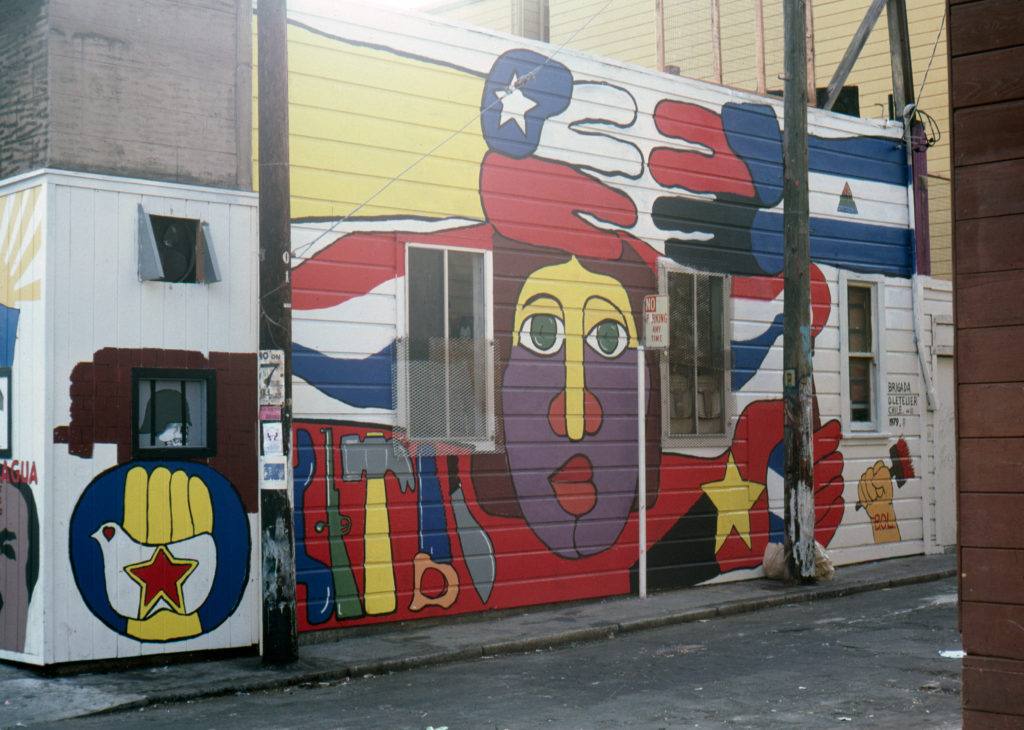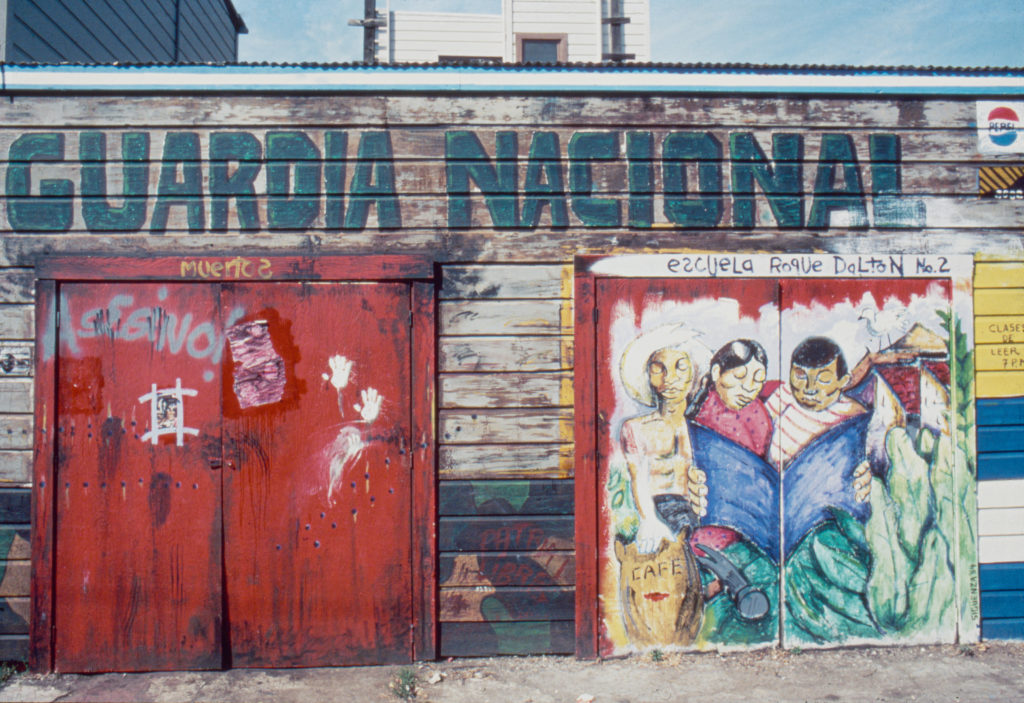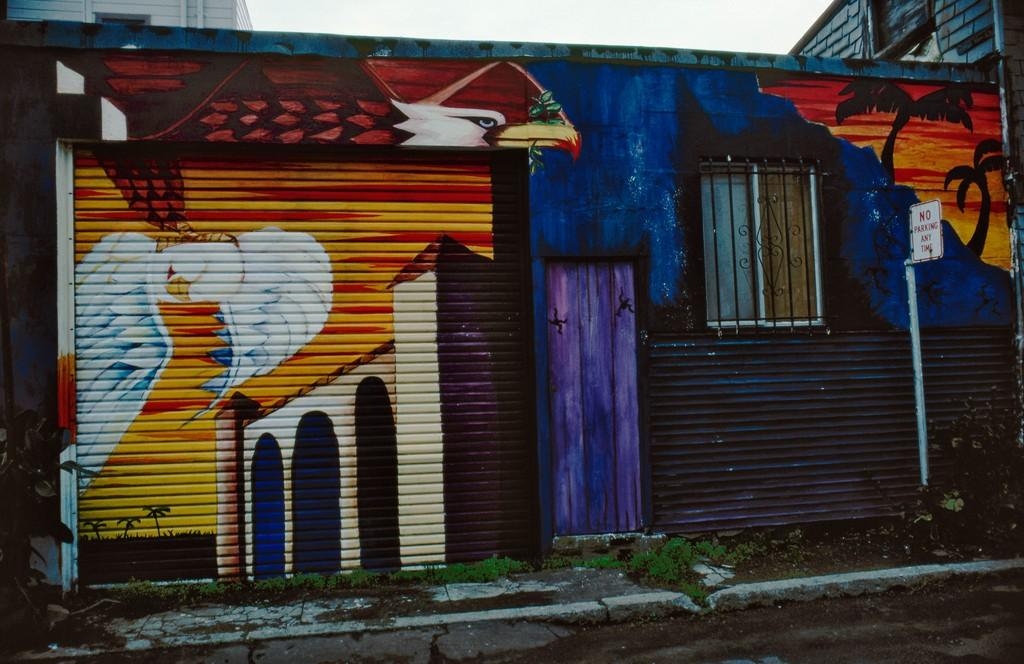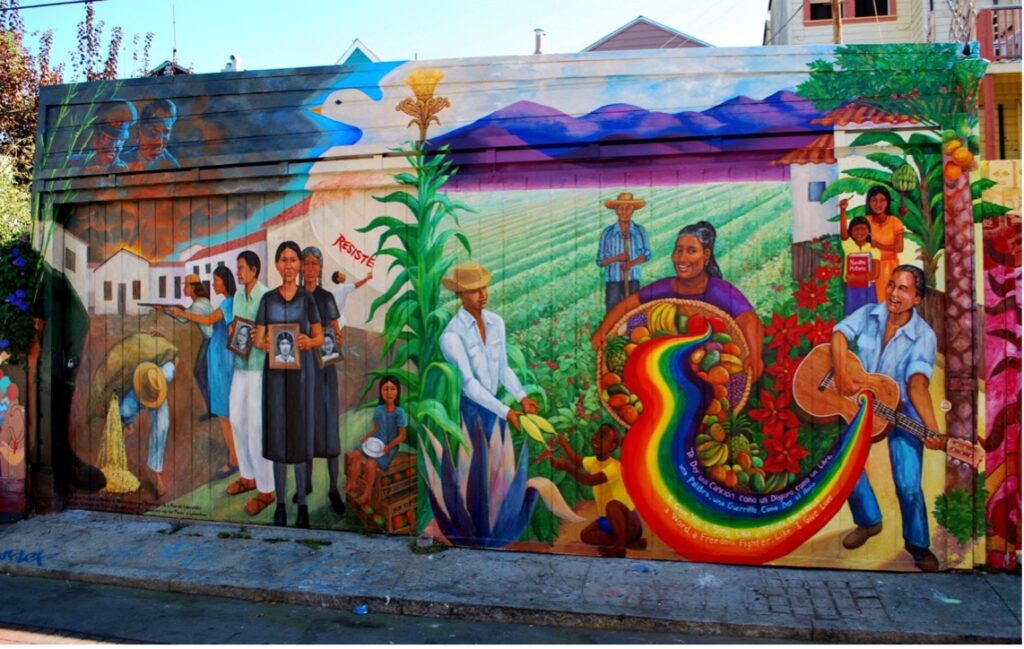In the late 1970s and throughout the 1980s, large waves of Central American immigrants arrived in the San Francisco Bay Area, spurred by civil wars in El Salvador, Guatemala, and Nicaragua. At the time, North American and Central American solidarity activists bravely mobilized thousands to agitate in the streets against President Ronald Reagan’s foreign policy in Central America.[i] San Francisco was one of the most politically progressive and active cities in the nation, a climate that encouraged wide participation in public demonstrations, mass protests, and mobilization against U.S. intervention in Central America. Visual artists from San Francisco began displaying their solidarity through community murals, transforming neighborhoods and developing visual markers and representations of Central American history and culture.
This article explores key moments that transformed a small quaint alley at the heart of the Mission District into one of the most politically and visually active spaces in San Francisco with what I call Central American solidarity murals. Community murals were political acts, a departure from conventional institutional politics, where artists used their imagination and paintbrushes to create a visual politics on the public streets. Balmy Alley became the catalyst for Central American solidarity murals to flourish, while urging the public to further their consciousness of the civil wars in the region.
Balmy Alley: A Space and Place for Murals
What made Balmy Alley a unique space to welcome Central American murals in the eighties? First, its location. Balmy lies just off 24th Street, which hosts several Latinx businesses, restaurants, and markets, making it a prime location for foot traffic. One of the first murals created in the alley was painted by Mia Galaviz de Gonzalez, who orchestrated a children’s mural project in 1972.[ii] Soon after, Graciela Carrillo (who now goes by Grace) and Patricia Rodriguez of the collective mural group known as Mujeres Muralistas created a mural there, aided by a supply of paint from Galaviz de Gonzalez.[iii] These two murals played a significant role in preparing the foundation for more to come.
One of the first murals depicting solidarity with the Nicaraguan Sandinistas was painted on Casa Nicaragua, wrapped around the corner of Balmy and 24th Street. It was created by the Brigada Orlando Letelier, a muralist collective from Chile established in homage to the Chilean diplomat Letelier, who had been assassinated on September 21, 1976, in Washington, D.C., via a car bomb planted by Pinochet’s secret police. Although geographically distant, both Chile and Nicaragua had experienced military dictatorships and U.S. interventions; thus, in 1979 the artists were forging solidarity with the Nicaraguan liberation movement. On the wall facing Balmy Alley, two large hands reach toward each other (fig.1). One hand is decorated with a Nicaraguan national flag, the other a Chilean. The mural was painted with bold graphic lines, a “flat style” adopted in Chilean murals during the Salvador Allende government.[iv] On the 24th Street side, a portrait of the revolutionary Augusto Sandino was placed in the center with a Frente Sandinista de Liberación Nacional (FSLN) flag and a Nicaragua flag floating behind him. Casa Nicaragua would mark one of the first Central American solidarity murals in the Mission District.

Leaving a “PLACA” in Balmy Alley
Inspired by the nationwide “Artists’ Call against U.S. Intervention in Central America,” a movement that began in New York City in 1983, Ray Patlán and Patricia Rodriguez recruited local San Francisco artists to bring attention to the civil wars of El Salvador, Guatemala, Honduras, and Nicaragua. They both lived in Balmy Alley and envisioned creating several murals that denounced U.S. intervention in Central America, but they did not want to associate their project with the nationwide Artists’ Call. Instead, they gave the project the name PLACA. In Spanish, placa holds multiple meanings, such as “badge,” “nameplate,” “license plate,” or “plaque”; it also closely aligns with the slang term “leaving your mark” or “graffiti tag,” known as a placazo in Spanish. PLACA aimed to leave a permanent mark in Balmy Alley with the creation of twenty-seven murals by thirty-six artists. This group of multiracial muralists changed what collaborative murals and solidarity could look like by creating a visual projection of a possible alternative world.
The project began strategically during a span of nine months on the block of Balmy Alley between 24th and 25th Streets. PLACA was funded by a single $2,500 grant from the Zellerbach Family Foundation.[v] Tim Drescher, a PLACA member and historian, noted that the mural cluster transformed the entire alley and formed a significant presence that any single piece could not command on its own.[vi] Art historian Guisela Latorre has defined a mural environment as a series of murals close to one another and within a defined space. These murals are not to be seen as single works of art; rather, their position and iconography should be understood in the context of the surrounding murals and the space in which they reside.[vii] PLACA’s characteristics as a mural environment marked a first for community mural history in San Francisco.
PLACA was unique for the diversity of its participants; the artists were from different racial backgrounds. Although the goal of PLACA was to promote solidarity and peace in Central America, only one participant was of Central American descent. Herbert Sigüenza, American visual artist and actor, was born and raised in San Francisco after his parents emigrated from El Salvador in the 1940s. During the seventies, Sigüenza worked at La Raza Silkscreen Center as a printmaker, creating hundreds of posters for events, charities, and fundraisers. Patlán asked Sigüenza to join him in creating a mural for PLACA. In 1984, the same year he created that mural, Sigüenza cofounded the theater performance comedic group known as Culture Clash at Galería de la Raza only a few blocks away from Balmy Alley. The creation of Culture Clash was significant in Sigüenza’s personal trajectory as he shifted his visual arts career toward playwriting and acting.
Sigüenza’s contribution to PLACA was a mural titled Después del triunfo/After the Triumph (1984, fig. 2). The concept was a theater set design replicating scenes of a hypothetical “postrevolutionary” El Salvador, as if the revolutionary group Farabundo Martí National Liberation Front (FMLN) had won the civil war. The mural testifies to Sigüenza’s experimental sensibility of incorporating theater set design into a public mural to bring a Salvadoran presence and depiction into the Mission District. For example, Sigüenza intentionally made the wall look old and weathered down by leaving certain sections without primer, imitating the streets of El Salvador. Furthermore, signs that indicate the scene is in El Salvador are the Pepsi and ADOC logos painted in the upper right corner. Pepsi and other beverages were popular across Latin America in the 1980s; their logos were often hand-painted on storefront walls. U.S. Americans may not recognize the logo painted in black and orange with the white letters ADOC (and the board edges make it hard to see in the photograph), but for Central Americans it is quite recognizable. Empresas ADOC was founded in 1953 in El Salvador as a shoe manufacturing company; by 1990 it was the largest manufacturer of shoes in Central America.[viii] The ADOC logo is particularly representative of Central America. All these visual indicators help to create the environment Sigüenza envisioned from having lived in El Salvador. The mural evokes Holly Barnet-Sánchez and Tim Drescher’s assertion that “Balmy Alley is in Central America and vice versa.”[ix] In Después del triunfo, Sigüenza depicts two alternative futures for the war-torn country of El Salvador.

This mural reads from left to right, with the left representing the violence of the war and the right symbolizing a new beginning after the triumph of the revolutionary forces, as the title indicates. On the left side, a red door has the word muertos (the dead) written above it. The door is painted with black bullet holes spanning it. The word asesino (murderer or assassin) is painted in gray spray paint. The two white handprints are a well-known symbol the death squads used to evoke fear in any passerby who reads the images. If a person was accused of being involved in subversive activities during the civil war, the death squads would leave a white handprint on the front door of the alleged subversive’s house. One of the first appearances of la mano blanca was in Guatemala in the 1960s; several death squads from other Central American countries appropriated it later.
In contrast, the door on the right reads “Escuela Roque Dalton #2” (Roque Dalton School #2), demonstrating an alternative future, far from imminent death, for the working-class campesino. In the center, a young couple sits reading a book together. Directly to the left, a campesino holds a burlap sack filled with coffee beans, a nod to El Salvador’s long history of exporting coffee to the United States. Sigüenza’s inclusion of the coffee beans in this mural also speaks to the profound relationship between Central America and the United States. The economies of four out of the seven Central American countries (Costa Rica, El Salvador, Guatemala, and Nicaragua) relied on coffee exports from the second half of the nineteenth century until approximately 1950. (The dominant export in Honduras was bananas, not coffee, until after World War II.)[x] In part, Sigüenza’s personal experience having seen the conditions in which Salvadoran campesinos lived expanded his worldview on the capitalist commodity of coffee. This section of the mural is a critique of the labor exploitation of the working class that had gone on for almost a century.
In large, bold, green letters, the words “Guardia Nacional” (National Guard) dominate the top of the entire garage structure on which Sigüenza painted Después del triunfo. The National Guard was established in El Salvador early in the twentieth century as a rural police force. By the seventies, it had become an icon of governmental authority and power in the countryside and was responsible for most of the violence against rural workers and peasants.[xi] Throughout the eighties, these police brutality and human rights abuses continued. Sigüenza incorporated this signage to replicate a Guardia Nacional precinct. The artist included the blue-and-white stripes of the national flag of El Salvador across the top of the mural to convey the national pride of the institution. Yet because the mural is set in a postrevolutionary El Salvador, Sigüenza imagined this National Guard station had been abandoned and converted into a school. To envision that future, Sigüenza highlighted the National Guard in his mural, only to have the institution disappear after a hypothetical revolutionary triumph. Although the left-wing victory never occurred, the dissolution of the National Guard did become a reality when it was disbanded in 1992, in accordance with the Peace Accords of Chapultepec that ended the Salvadoran civil war. Sigüenza’s mural contribution and perspective as a U.S.-born citizen who lived in El Salvador for several years of his childhood is unique to PLACA.

Another mural that criticizes U.S. intervention is Carlos “Kookie” Gonzalez’s Keeping the Peace in Central America (1984) (fig. 3). Gonzalez, who describes himself as a Chicano artist who was raised in the Mission District, viewed Patlán as a mentor. At the time, he was one of the youngest PLACA members. A twenty-two-year-old college student attending San Francisco State College, he was aware of the conditions in which Central Americans lived during the war and attributed his knowledge of the conflicts to local residents, who shared stories of their war experiences.
Gonzalez’s 1984 mural is a sharp political critique of U.S. empire yet simple in its iconic imagery. Most of the mural is painted on the outside facade of a garage—a roll-down garage door, and partially on a wooden door. Its dual theme relates to issues occurring in the United States and Central America. In the upper left corner, a bald eagle grips a white dove in its talons. Although subtle, these two birds juxtapose war and peace while referencing the civil war occurring in El Salvador. During the summer of 1984, the Olympics took place in Los Angeles, California; Sam the Olympic Eagle, a nonthreatening cartoon character, was the official mascot. Reminiscent of Uncle Sam, the bird wore a red-and-white-striped bowtie and an oversized top hat featuring red-and-white stripes and a white Olympic logo over a blue hatband. In Keeping the Peace in Central America, the eagle is an imposing figure, clutching a dead dove in its talons. In an interview, Gonzalez elaborated on the juxtaposition he used in the mural. “I took the mascot, Sam the Olympic Eagle, and used him as a ‘bad guy’ in Central America, holding a dead dove, which is the symbol of peace, flying through a blown-up Central American village . . . and in the background there is a blown-up house with a death squad hand, la mano blanca, imprinted on the door.”[xii] Gonzalez reanimates the bleak narrative that Salvadorans endured during the civil war through his direct and layered iconography.

Miranda Bergman and O’Brien Thiele were both experienced muralists when they joined PLACA. They collaborated to create Culture Contains the Seed of Resistance, Which Blossoms into the Flower of Liberation (1984), which depicts scenes that could have existed in any of the three Central American countries undergoing civil war (El Salvador, Guatemala, or Nicaragua) (fig. 1.4.). Covering the rear of a garage, the mural is split into two scenes depicting the war and rural life. The left side depicts scenes from a war, where a village house is burning; above the clouds of smoke two military figures look over the destruction. At the forefront stands a group of mothers carrying photographs of their “disappeared” family members. A young boy in the background is painting the word resiste on the wall with red paint. The right side of the mural paints a brighter future, with lush harvests, farm work, and peaceful music. A man is playing a guitar with the lyrics from Silvio Rodríguez’s 1976 song “Te doy una canción” flowing out as a rainbow. After the Spanish words, the English states: “I give you a song like a tribute, like a book, a word, a freedom fighter, like I give love.” Including this lyric references the impact the Nueva Canción genre had on revolutionary movements across Latin America. The mural’s symbolic representations allow the audience to understand the multifaceted dimensions of the civil wars. It still stands in Balmy Alley and was restored in 2014. Nearly forty years after it was first painted, the mural remains a snapshot of the past but also of the present. It remains a testament to how the Central American diaspora shaped the city’s activism and its history.
PLACA remains a symbol of hope for transnational solidarity. As Bergman put it, “PLACA was a symbol and metaphor for transformation, that if we can transform this alley with paint, then we can transform our human cultures.”[xiii] As the original murals faded or weathered with time, newer ones brought the same spirit of social justice to other causes such as gentrification, wars, Indigenous rights, and women’s rights. Central America–themed murals continued to be painted throughout subsequent decades as well, including Susan Kelk Cervantes and Nicole Emanuel’s Indigenous Eyes (1991), Juana Alicia’s Una ley inmoral nadie tiene que cumplirla (1996), Jamie Morgan’s A Tribute to Archbishop Oscar Romero (2001), Joel Bergner’s Un pasado que aún vive (2004), and Josué Rojas’s Enrique’s Journey (2009). Ultimately, the artists who painted in solidarity with Central America were producing their work from the epicenter of U.S. power, and their murals established a counterspace against intervention from within the empire.
Notes
- Patricia R. Stuelke, The Ruse of Repair: US Neoliberal Empire and the Turn from Critique (Durham, NC: Duke University Press, 2021), 109.
- Cary Cordova, The Heart of the Mission: Latino Art and Politics in San Francisco (Philadelphia: University of Pennsylvania Press, 2017), 144.
- Cordova, Heart of the Mission, 145.
- Timothy W. Drescher, “The Brigada Orlando Letelier,” Community Murals (Fall 1981): 5.
- Timothy W. Drescher, “Street Subversion: The Political Geography of Graffiti and Murals,” in Reclaiming San Francisco: History, Politics, Culture, ed. James Brook, Chris Carlsson, and Nancy J. Peters (San Francisco: City Lights Books, 1998), 235.
- Drescher, “Street Subversion,” 235–36.
- Guisela Latorre, Walls of Empowerment: Chicana/o Indigenist Murals of California (Austin: University of Texas Press, 2008), 142.
- More information can be found on the Empresas ADOC website, www.empresasadoc.com/.
- Holly Barnet-Sánchez and Timothy W. Drescher, “Taking Chicana/o and Solidarity Murals Seriously,” in Rewriting the Chicano Movement: New Histories of Mexican American Activism in the Civil Rights Era, ed. Mario T. García and Ellen McCracken (Tucson: University of Arizona Press, 2021), 170–94.
- C. F. S. Cardoso, “Historia económica del café en Centroamérica (siglo XIX),” Estudios Sociales Centroamericanos 4, no. 10 (1975): 9–55.
- Aldo A. Lauria-Santiago, “The Culture and Politics of State Terror and Repression in El Salvador,” in When States Kill: Latin America, the U.S., and Technologies of Terror, ed. Cecilia Menjívar and Néstor Rodríguez (Austin: University of Texas Press, 2005), 94.
- Carlos Gonzalez, interview with the author, March 14, 2011.
- Miranda Bergman, interview with the author, November 16, 2020.